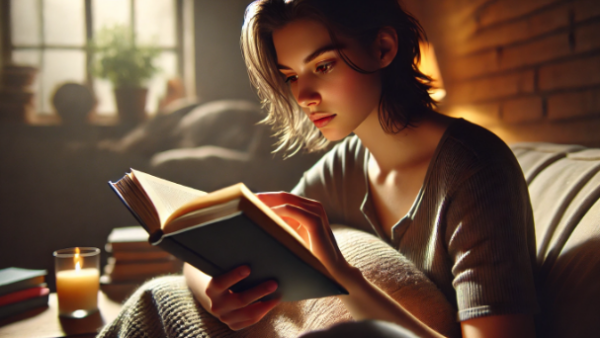You’ve probably been there—sitting in front of your screen, fingers poised over the keyboard, waiting for the perfect opening line to just appear. It doesn’t. Instead, you start to wonder if maybe, just maybe, you’ve already used up all your best words.
But here’s the thing: You’re not alone. Even the best writers have agonized over that very first line, knowing it can make or break the reader’s journey. After all, who hasn’t picked up a book, read the first sentence, and decided to either dive in or put it back on the shelf faster than you can say, “It was a dark and stormy night”?
No pressure, right?
But don’t worry—we’ve got you covered. In this article, we’re going to break down the art of writing unforgettable opening lines, from creating intrigue to establishing your voice. And by the end, you’ll be ready to craft that perfect sentence to hook readers in—because we all know they deserve more than just a “once upon a time.”
Let’s dive in, shall we?
Tip #1: Hook Your Readers with Action or Intrigue
One of the fastest ways to grab a reader’s attention is to drop them right into the middle of something interesting. Whether it’s a dramatic event, an unexpected moment, or a peculiar scene, starting with action or intrigue leaves readers no choice but to keep reading.
Think about George Orwell’s unforgettable opening to 1984:
“It was a bright cold day in April, and the clocks were striking thirteen.”
It’s strange, right? Clocks don’t strike thirteen, but now we’re curious—and we’re pulled into Orwell’s dystopian world from the very first line.
Your Publishing Journey Awaits – Start NowBy starting with action or something that doesn’t quite make sense, you create an immediate question in the reader’s mind: “What’s happening here?” That question is exactly what keeps them turning the page.
To apply this to your own writing, ask yourself: What’s a moment of action or intrigue that could kick off your story? It doesn’t have to be a fight scene or a car chase. It could be something as simple as a character’s startling realization, a shocking discovery, or an unusual setting that throws the reader off balance just enough to keep them hooked.
Because when you start with a bang, it’s hard for readers not to stick around to see what happens next.
Tip #2: Establish a Unique Voice From The Start
Your opening line is the perfect place to introduce not just your story, but you—or at least your character. A strong, unique voice can pull readers in just as effectively as action or intrigue. Think of it like meeting someone new: within seconds, you’ve already got a sense of their personality. The same should happen with your first sentence.
Take Moby Dick’s famous opener, “Call me Ishmael.” It’s simple, but that one line introduces us to a narrator with an unmistakable voice. You can already sense Ishmael’s straightforward, slightly mysterious demeanor—and all with just three words.
Your voice sets the tone for everything that follows. Whether your narrator is humorous, serious, cynical, or hopeful, the opening line is the perfect chance to show the reader who’s in charge of this story. It’s like giving them a sneak peek into the personality of your main character or the overall feel of your book.
To do this in your own writing, think about the attitude, tone, and style you want to convey from the very first word. Is your narrator quirky? Use a line that reflects that. Is your story dark and brooding? Choose words that match that atmosphere. Your opening line doesn’t just tell readers what’s happening—it shows them how it’s happening, through the lens of a distinct voice that they won’t want to stop listening to.
After all, nobody wants a monotone tour guide through a thrilling adventure, right?
Tip #3: Unveil Conflict or a Mystery to Draw Readers In
Nothing hooks a reader faster than a juicy conflict or a compelling mystery. When your first line hints at trouble ahead, it creates immediate tension—and tension is irresistible. Readers want to know what’s wrong and how it’s going to be fixed (or if it ever will be). An opening line that teases conflict or mystery gives them no choice but to keep going.
Consider Albert Camus’s The Stranger:
“Mother died today.”
That single sentence drops a heavy, emotional bomb. Instantly, you’re curious—not just about how the narrator feels, but about what’s going to happen next. There’s an emotional conflict embedded in that line, and we’re drawn in because we know this event will define the rest of the story.
The beauty of opening with conflict or mystery is that it doesn’t have to be dramatic. It could be as subtle as a character wrestling with a personal dilemma or as simple as something feeling a bit off in the world you’ve created. The key is to leave your reader asking questions. What happened? Why did it happen? What will happen next?
When you start with a problem, you’re creating a narrative itch that only turning the page will scratch. And once the reader’s hooked by that itch, they’re in for the long haul.
Tip #4: Set the Scene with Strong Sensory Details
Sometimes, the best way to draw readers in is to immerse them fully into your story’s world from the very first line. By using rich sensory details, you can transport readers right into the setting, making them feel like they’re standing there with your characters, hearing the sounds, smelling the air, and feeling the atmosphere around them.
Take the infamous “It was a dark and stormy night” from Edward Bulwer-Lytton’s Paul Clifford. Sure, it’s become a bit of a cliché, but it works. Instantly, you know the mood: ominous, foreboding, and full of potential danger. Or consider this from Gabriel García Márquez’s One Hundred Years of Solitude:
“The rain fell in the distant afternoon.”
That single sentence conjures an image of a quiet, melancholy day—just with the sound of raindrops in the background.
To use this technique in your own writing, think about the senses. What does your character see, hear, feel, smell, or even taste in the opening moment? Is the air thick with tension, or is there a calm before the storm? By grounding your reader in a vivid scene, you set the tone for what’s to come while giving them a clear sense of place.
When done well, sensory details don’t just create atmosphere—they make your world feel real. And when readers feel like they’re standing right there with your characters, they’re far more likely to stay with the story until the very last page.
Tip #5: Make a Philosophical or Universal Statement
Sometimes, the best way to start a story is by offering a thought that resonates universally—a statement that instantly makes readers pause and reflect. A great philosophical opening can set the tone for a novel and hint at the deeper themes that will unfold, drawing readers in with its wisdom or wit.
Take, for example, Jane Austen’s iconic line from Pride and Prejudice:
“It is a truth universally acknowledged, that a single man in possession of a good fortune must be in want of a wife.”
This sentence is both humorous and insightful, hinting at societal expectations while setting up the book’s exploration of relationships, wealth, and class. It invites the reader to consider the truth of the statement while also laying the groundwork for what’s to come.
Opening with a universal truth or philosophical observation gives your story weight right from the beginning. It suggests that what follows is not just about characters and plot, but about bigger ideas that can apply to anyone’s life.
To do this in your own writing, think about a central theme or idea in your story that could be distilled into a single statement. It could be about love, loss, power, or human nature—something that taps into the shared experiences of readers everywhere. By offering a line that resonates beyond your specific plot, you’re telling readers that your story has something to say about the world, and they’re likely to keep reading to discover what that is.
After all, who can resist a bit of wisdom to kick off a great read?
Tip #6: Surprise Your Reader with the Unexpected
Few things grab a reader’s attention like a twist right from the very first line. A surprising or unusual statement in your opening sentence can intrigue, shock, or even amuse your audience, making them eager to uncover the story behind that unexpected moment.
Take the unforgettable opener from Toni Morrison’s Paradise:
“They shoot the white girl first.”
This line is startling, direct, and immediately raises questions. Who are “they”? Why is the “white girl” being shot? And why is it happening first? In just a few words, Morrison throws us off balance, and the only way to regain our footing is to read on.
Your Publishing Journey Awaits – Start NowSurprise doesn’t always have to come from something shocking—it can also be a quirky or humorous observation that makes readers smile. The goal is to break their expectations and make them curious about what’s going on or where this unexpected beginning will lead.
In your own writing, think about how you can use surprise to shake up your readers. It could be through a strange situation, an out-of-place detail, or a character doing something completely unexpected. When you lead with the unusual, you’re creating an irresistible pull that invites readers to dive deeper into the story.
After all, who can resist the urge to understand the “why” behind the unexpected?
Tip #7: Start with a Strong Character Introduction
Sometimes, the best way to open a story is by introducing readers to a character who instantly grabs their attention. Whether it’s through their thoughts, actions, or unique circumstances, starting with a memorable character can immediately hook your audience and make them curious about this person’s journey.
Consider the famous opening of Leo Tolstoy’s Anna Karenina:
“All happy families are alike; each unhappy family is unhappy in its own way.”
This line doesn’t just introduce a concept—it introduces the essence of the characters we’re about to meet. It hints at the complexities and struggles they will face, setting the stage for the personal dramas that unfold in the novel.
Introducing a character right away gives readers someone to latch onto. It can be a name, an internal conflict, or an odd quirk that makes them stand out. Think of it as giving your readers a guide to follow through the story—a person they want to understand better.
To apply this in your writing, ask yourself: Who is your main character, and what’s the most intriguing thing about them that you can reveal in the very first line? Whether it’s a personal struggle, a bold action, or a unique worldview, giving readers a glimpse into the character from the outset can make them eager to learn more about their story.
After all, stories are about people, and readers love to meet a character who promises an interesting adventure.
The first line of your book is your chance to make a lasting impression, so make it count. Whether you choose to start with action, a unique voice, sensory details, or a surprising twist, your opening line sets the tone for the journey ahead. Remember, there’s no one-size-fits-all formula—find what works best for your story and your style.
Now it’s your turn: experiment, take risks, and let that unforgettable first line draw readers into the world you’ve created. Because, as they say, you never get a second chance to make a first impression!
Transform Your Writing with Spines
Now that you’ve mastered the art of crafting unforgettable opening lines, are you ready to take your writing to the next level? Spines is here to help. Founded in 2020, Spines combines advanced AI technology with human expertise to make the publishing process faster, more affordable, and globally accessible. Whether you’re publishing an eBook, print-on-demand, or audiobook, our intuitive platform supports all formats, helping you reach readers around the world.
With Spines, you can publish in under 30 days, access affordable plans starting at just $99 per month, and enjoy global distribution through major retailers like Amazon and Barnes & Noble. Plus, we offer dedicated support with a personal production manager guiding you every step of the way.
Ready to turn your manuscript into a published masterpiece? Start your journey with Spines today and make sure your story reaches its fullest potential.
Your Publishing Journey Awaits – Start Now






